状语放句首引发的倒装句
- 格式:docx
- 大小:9.10 KB
- 文档页数:4
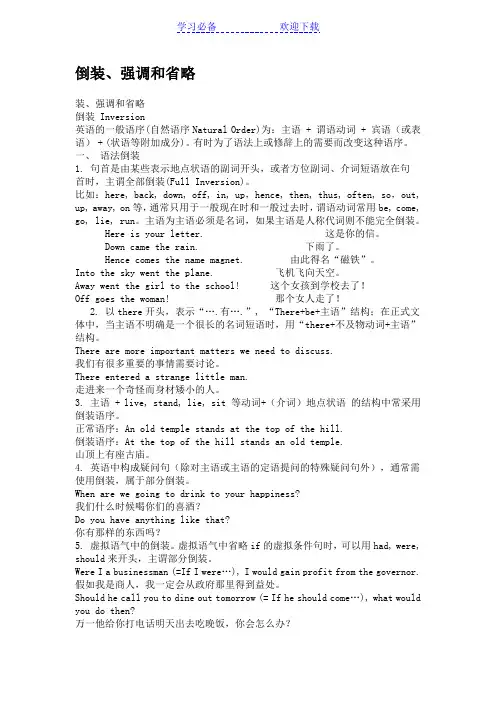
倒装、强调和省略装、强调和省略倒装 Inversion英语的一般语序(自然语序Natural Order)为:主语 + 谓语动词 + 宾语(或表语) + (状语等附加成分)。
有时为了语法上或修辞上的需要而改变这种语序。
一、语法倒装1. 句首是由某些表示地点状语的副词开头,或者方位副词、介词短语放在句首时,主谓全部倒装(Full Inversion)。
比如:here, back, down, off, in, up,hence, then, thus, often, so,out, up, away, on等,通常只用于一般现在时和一般过去时,谓语动词常用be, come, go, lie, run。
主语为主语必须是名词,如果主语是人称代词则不能完全倒装。
Here is your letter. 这是你的信。
Down came the rain. 下雨了。
Hence comes the name magnet. 由此得名“磁铁”。
Into the sky went the plane. 飞机飞向天空。
Away went the girl to the school! 这个女孩到学校去了!Off goes the woman! 那个女人走了!2. 以there开头,表示“….有….”, “There+be+主语”结构;在正式文体中,当主语不明确是一个很长的名词短语时,用“there+不及物动词+主语”结构。
There are more important matters we need to discuss.我们有很多重要的事情需要讨论。
There entered a strange little man.走进来一个奇怪而身材矮小的人。
3. 主语 + live, stand, lie, sit 等动词+(介词)地点状语的结构中常采用倒装语序。
正常语序:An old temple stands at the top of the hill.倒装语序:At the top of the hill stands an old temple.山顶上有座古庙。
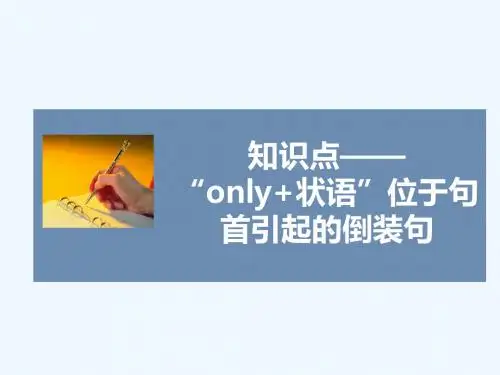
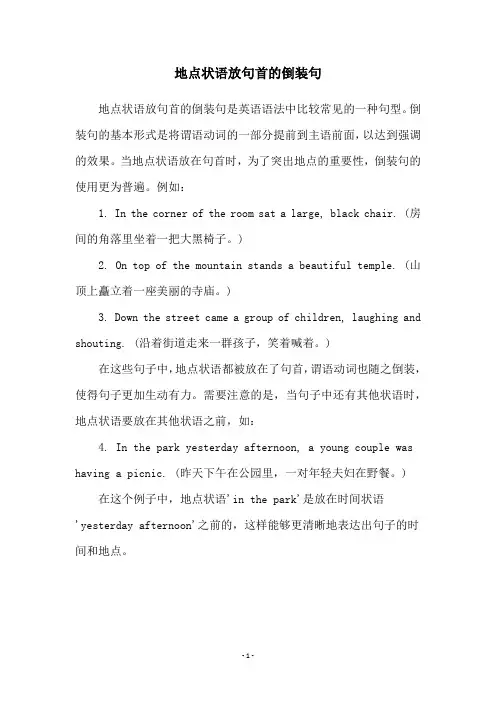
地点状语放句首的倒装句
地点状语放句首的倒装句是英语语法中比较常见的一种句型。
倒装句的基本形式是将谓语动词的一部分提前到主语前面,以达到强调的效果。
当地点状语放在句首时,为了突出地点的重要性,倒装句的使用更为普遍。
例如:
1. In the corner of the room sat a large, black chair. (房间的角落里坐着一把大黑椅子。
)
2. On top of the mountain stands a beautiful temple. (山顶上矗立着一座美丽的寺庙。
)
3. Down the street came a group of children, laughing and shouting. (沿着街道走来一群孩子,笑着喊着。
)
在这些句子中,地点状语都被放在了句首,谓语动词也随之倒装,使得句子更加生动有力。
需要注意的是,当句子中还有其他状语时,地点状语要放在其他状语之前,如:
4. In the park yesterday afternoon, a young couple was having a picnic. (昨天下午在公园里,一对年轻夫妇在野餐。
) 在这个例子中,地点状语'in the park'是放在时间状语
'yesterday afternoon'之前的,这样能够更清晰地表达出句子的时间和地点。
- 1 -。
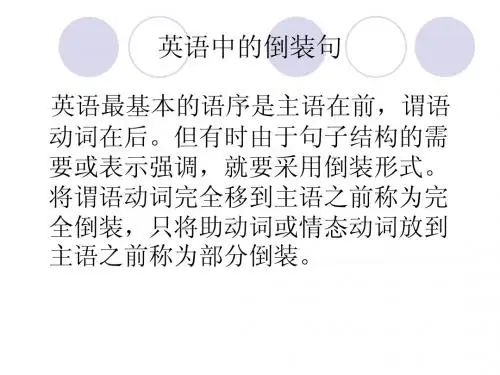
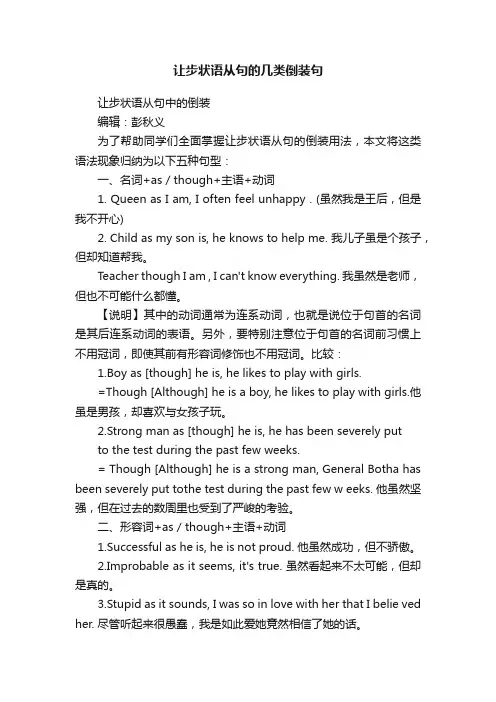
让步状语从句的几类倒装句让步状语从句中的倒装编辑:彭秋义为了帮助同学们全面掌握让步状语从句的倒装用法,本文将这类语法现象归纳为以下五种句型:一、名词+as / though+主语+动词1. Queen as I am, I often feel unhappy . (虽然我是王后,但是我不开心)2. Child as my son is, he knows to help me. 我儿子虽是个孩子,但却知道帮我。
Teacher though I am , I can't know everything. 我虽然是老师,但也不可能什么都懂。
【说明】其中的动词通常为连系动词,也就是说位于句首的名词是其后连系动词的表语。
另外,要特别注意位于句首的名词前习惯上不用冠词,即使其前有形容词修饰也不用冠词。
比较:1.Boy as [though] he is, he likes to play with girls.=Though [Although] he is a boy, he likes to play with girls.他虽是男孩,却喜欢与女孩子玩。
2.Strong man as [though] he is, he has been severely putto the test during the past few weeks.= Though [Although] he is a strong man, General Botha has been severely put tothe test during the past few w eeks. 他虽然坚强,但在过去的数周里也受到了严峻的考验。
二、形容词+as / though+主语+动词1.Successful as he is, he is not proud. 他虽然成功,但不骄傲。
2.Improbable as it seems, it's true. 虽然看起来不太可能,但却是真的。
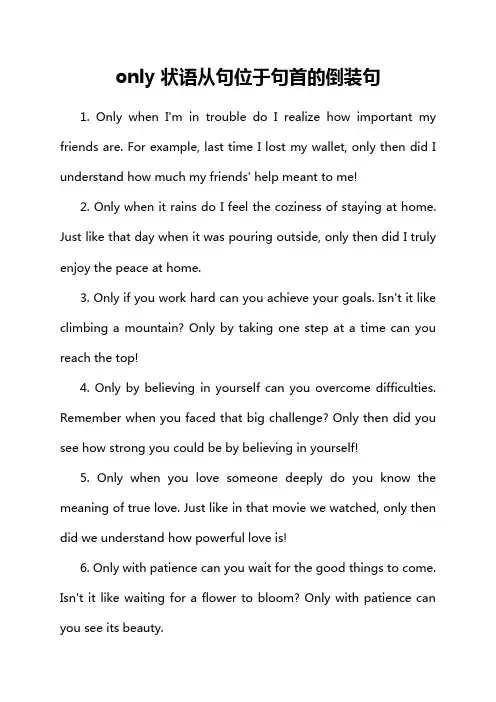
only 状语从句位于句首的倒装句1. Only when I'm in trouble do I realize how important my friends are. For example, last time I lost my wallet, only then did I understand how much my friends' help meant to me!2. Only when it rains do I feel the coziness of staying at home. Just like that day when it was pouring outside, only then did I truly enjoy the peace at home.3. Only if you work hard can you achieve your goals. Isn't it like climbing a mountain? Only by taking one step at a time can you reach the top!4. Only by believing in yourself can you overcome difficulties. Remember when you faced that big challenge? Only then did you see how strong you could be by believing in yourself!5. Only when you love someone deeply do you know the meaning of true love. Just like in that movie we watched, only then did we understand how powerful love is!6. Only with patience can you wait for the good things to come. Isn't it like waiting for a flower to bloom? Only with patience can you see its beauty.7. Only in the morning do I have the most energy. Every day when I wake up, only then do I feel ready to take on the world!8. Only by learning from mistakes can you grow. Just like when you made that mistake last time, only then did you learn and become better.9. Only when you are kind to others do they return the kindness. Have you ever experienced that? Only then do you know how good it feels to be kind.10. Only by taking risks can you achieve great things. Isn't it like jumping into the unknown? Only by being brave can you discover new horizons.My view is that these "only"倒装句 really show the importance and uniqueness of certain situations, and they make our language more vivid and emotional.。
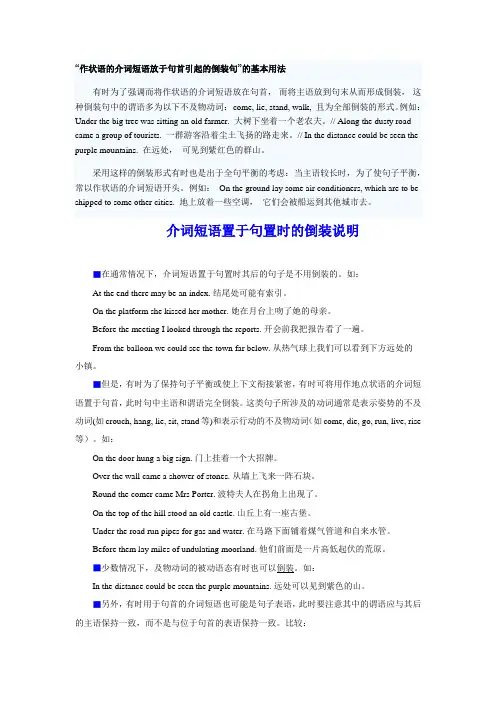
“作状语的介词短语放于句首引起的倒装句”的基本用法有时为了强调而将作状语的介词短语放在句首,而将主语放到句末从而形成倒装,这种倒装句中的谓语多为以下不及物动词:come, lie, stand, walk, 且为全部倒装的形式。
例如:Under the big tree was sitting an old farmer. 大树下坐着一个老农夫。
// Along the dusty road came a group of tourists. 一群游客沿着尘土飞扬的路走来。
// In the distance could be seen the purple mountains. 在远处,可见到紫红色的群山。
采用这样的倒装形式有时也是出于全句平衡的考虑:当主语较长时,为了使句子平衡,常以作状语的介词短语开头。
例如:On the ground lay some air conditioners, which are to be shipped to some other cities. 地上放着一些空调,它们会被船运到其他城市去。
介词短语置于句置时的倒装说明■在通常情况下,介词短语置于句置时其后的句子是不用倒装的。
如:At the end there may be an index. 结尾处可能有索引。
On the platform she kissed her mother. 她在月台上吻了她的母亲。
Before the meeting I looked through the reports. 开会前我把报告看了一遍。
From the balloon we could see the town far below. 从热气球上我们可以看到下方远处的小镇。
■但是,有时为了保持句子平衡或使上下文衔接紧密,有时可将用作地点状语的介词短语置于句首,此时句中主语和谓语完全倒装。
这类句子所涉及的动词通常是表示姿势的不及动词(如crouch, hang, lie, sit, stand等)和表示行动的不及物动词(如come, die, go, run, live, rise 等)。

部分倒装的8种情况例句一、部分倒装的第一种情况是只放句首的情况。
例句:Only when you have experienced it can you understand the feeling. "只有你经历过,你才能理解这种感觉。
"二、第二种情况是hardly, scarcely, no sooner等否定词引发的部分倒装。
例句:No sooner had he seen me than he ran over. "他一看到我就跑过来了。
"三、第三种情况是表示地点的副词或者地点状语置于句首的情况。
例句:In front of the house sat an old man. "在房子前面坐着一个老人。
"四、部分倒装的第四种情况是由so, neither, nor等代词引起的。
例句:So am I. "我也是。
"五、第五种情况是由as, though引起的让步状语从句的情况。
例句:Child as he is, he knows a lot. "虽然他是个孩子,但他知识渊博。
"六、部分倒装的第六种情况是在一些表示祝愿的句子中的情况。
例句:May you succeed! "祝你成功!"七、第七种情况是not until引发的倒装。
例句:Not until the teacher came in did the students start to study. "直到老师进来,学生们才开始学习。
"八、最后一种情况是在某些固定句型中的倒装,如表示方向的动词或词组放在句首的情况。
例句:Down went the ship. "船沉了。
"。
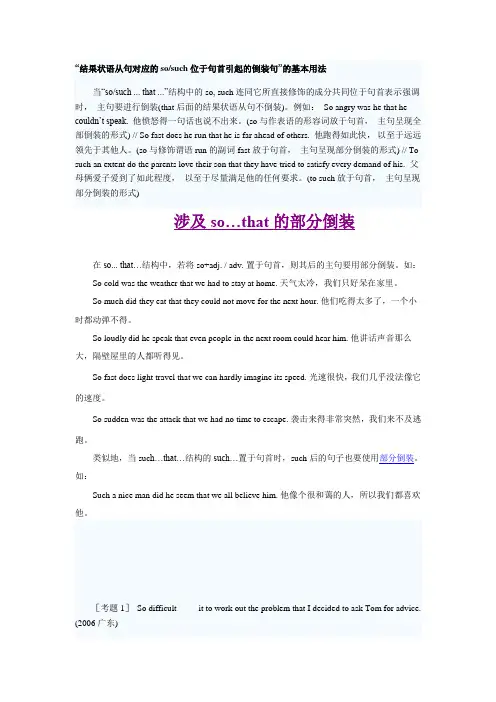
“结果状语从句对应的so/such位于句首引起的倒装句”的基本用法当“so/such ... that ...”结构中的so, such连同它所直接修饰的成分共同位于句首表示强调时,主句要进行倒装(that后面的结果状语从句不倒装)。
例如:So angry was he that he couldn’t speak. 他愤怒得一句话也说不出来。
(so与作表语的形容词放于句首,主句呈现全部倒装的形式) // So fast does he run that he is far ahead of others. 他跑得如此快,以至于远远领先于其他人。
(so与修饰谓语run的副词fast放于句首,主句呈现部分倒装的形式) // To such an extent do the parents love their son that they have tried to satisfy every demand of his. 父母俩爱子爱到了如此程度,以至于尽量满足他的任何要求。
(to such放于句首,主句呈现部分倒装的形式)涉及so…that的部分倒装在so... that…结构中,若将so+adj. / adv. 置于句首,则其后的主句要用部分倒装。
如:So cold was the weather that we had to stay at home. 天气太冷,我们只好呆在家里。
So much did they eat that they could not move for the next hour. 他们吃得太多了,一个小时都动弹不得。
So loudly did he speak that even people in the next room could hear him. 他讲话声音那么大,隔壁屋里的人都听得见。
So fast does light travel that we can hardly imagine its speed. 光速很快,我们几乎没法像它的速度。
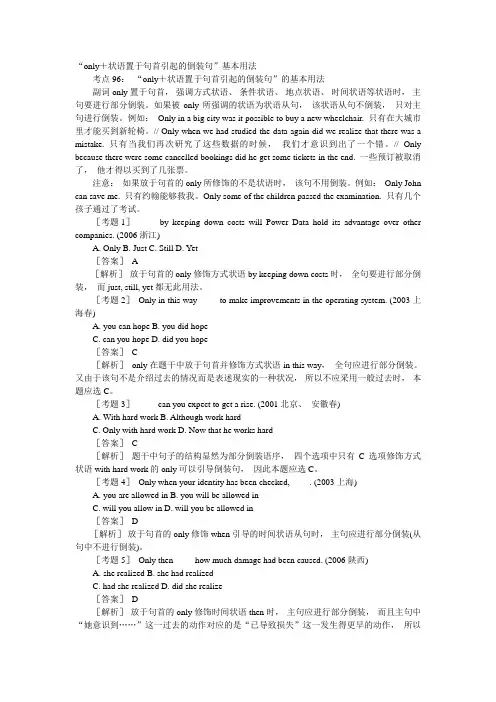
“only+状语置于句首引起的倒装句”基本用法考点96:“only+状语置于句首引起的倒装句”的基本用法副词only置于句首,强调方式状语、条件状语、地点状语、时间状语等状语时,主句要进行部分倒装。
如果被only所强调的状语为状语从句,该状语从句不倒装,只对主句进行倒装。
例如:Only in a big city was it possible to buy a new wheelchair. 只有在大城市里才能买到新轮椅。
// Only when we had studied the data again did we realize that there was a mistake. 只有当我们再次研究了这些数据的时候,我们才意识到出了一个错。
// Only because there were some cancelled bookings did he get some tickets in the end. 一些预订被取消了,他才得以买到了几张票。
注意:如果放于句首的only所修饰的不是状语时,该句不用倒装。
例如:Only John can save me. 只有约翰能够救我。
Only some of the children passed the examination. 只有几个孩子通过了考试。
[考题1]____ by keeping down costs will Power Data hold its advantage over other companies. (2006浙江)A. OnlyB. JustC. StillD. Yet[答案]A[解析]放于句首的only修饰方式状语by keeping down costs时,全句要进行部分倒装,而just, still, yet都无此用法。
[考题2]Only in this way ____ to make improvements in the operating system. (2003上海春)A. you can hopeB. you did hopeC. can you hopeD. did you hope[答案]C[解析]only在题干中放于句首并修饰方式状语in this way,全句应进行部分倒装。
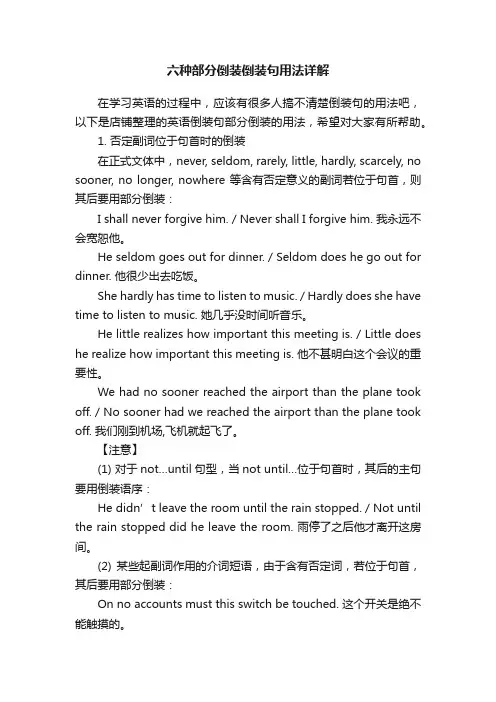
六种部分倒装倒装句用法详解在学习英语的过程中,应该有很多人搞不清楚倒装句的用法吧,以下是店铺整理的英语倒装句部分倒装的用法,希望对大家有所帮助。
1. 否定副词位于句首时的倒装在正式文体中,never, seldom, rarely, little, hardly, scarcely, no sooner, no longer, nowhere 等含有否定意义的副词若位于句首,则其后要用部分倒装:I shall never forgive him. / Never shall I forgive him. 我永远不会宽恕他。
He seldom goes out for dinner. / Seldom does he go out for dinner. 他很少出去吃饭。
She hardly has time to listen to music. / Hardly does she have time to listen to music. 她几乎没时间听音乐。
He little realizes how important this meeting is. / Little does he realize how important this meeting is. 他不甚明白这个会议的重要性。
We had no sooner reached the airport than the plane took off. / No sooner had we reached the airport than the plane took off. 我们刚到机场,飞机就起飞了。
【注意】(1) 对于not…until句型,当not until…位于句首时,其后的主句要用倒装语序:He didn’t leave the room until the rain stopped. / Not until the rain stopped did he leave the room. 雨停了之后他才离开这房间。
【导语】有⼀个现象是普遍存在的,就是“学的越多感觉不会的越多,背的越多忘的越快”,这个问题困扰着很多考研党。
很多时候死记硬背并不是的⽅法,需要找到正确的思路,灵活记忆。
?⽆忧考为同学们提供⼀些知识点考研英语语法之倒装结构:完全倒装和部分倒装,希望能对⼤家有所帮助。
在英语表达中,由于语法结构平衡的要求,或是由于修辞的需要,往往要改变句⼦的⾃然语序,把⼀些本应置于主语之后的谓语、表语或状语等句⼦成分提到主语之前。
我们把这种语序的变化称为“倒装语序”。
这样的倒装语序可能使句⼦的内在含义产⽣细微的、甚⾄明显的改变。
只有了解引起倒装的原因,才能更准确地理解句⼦的含义。
下⾯万学海⽂就跟⼤家聊聊倒装语序。
倒装语序分为完全倒装和部分倒装。
完全倒装(FullInversion),⼜称“全部倒装”,是指将句⼦中的谓语全部置于主语之前。
部分倒装(PartialInversion)(⼜称半倒装句),指将谓语的⼀部分如助动词或情态动词倒装⾄主语之前,⽽谓语动词⽆变化。
如果句中的谓语没有助动词或情态动词,则需添加助动词do,does或did,并将其置于主语之前。
考研英语翻译中倒装结构的突破⼝在于:识别出倒装结构,并判断出主语和谓语,找到句⼦主⼲,理清句中各部分的关系。
翻译时既可以按照主谓语的顺序翻译,也可以按照英语表达顺序翻译。
下⾯列举⼏个真题范例。
⼀、状语位于句⾸,主语⾮代词,句⼦完全倒装【真题例句】With economic growth has come centralization; fully 76 percent of Japan’s 119 million citizens live in cities where community and the extended family have been abandoned in favor of isolated, two-generation households.【解析】第⼀个句⼦主语centralization后⾯紧跟着第⼆个句⼦介绍centralization的内容,为使其保持紧凑,所以将介词短语With economic growth置于句⾸,第⼀个句⼦采⽤完全倒装结构。
Only位于句首的倒装句是英语语法中一个比较常见的句型,它的特点是将only置于句首,并且使用倒装结构。
这种句型在书面语和正式场合中经常出现,具有一定的语气、逻辑和语法特点。
下面将从几个方面对这种句型进行详细的解析。
1. 句型结构在only位于句首的倒装句中,通常将谓语动词或助动词提到主语之前,与之构成倒装结构。
例如:Only when the r本人n stopped did we go out for a walk.Only by working hard can you achieve your goals.Only by learning from mistakes can we improve ourselves.2. 基本用法这种句型通常用来强调时间、条件、原因、方式、目的等特定的情况或条件,在句中起到加强语气和表达重要性的作用。
例如:Only through practice can you master a skill.Only in this way can we solve the problem.Only when you follow the instructions can youplete the task.3. 状语从句中的用法在only位于状语从句的倒装句中,如果状语从句中包含助动词或情态动词,那么在倒装结构中,这些助动词或情态动词应跟在主语之前。
例如:Only when you have a clear goal can you make a plan for your future.Only if you practice regularly can you improve your English. Only when we work together can we achieve success.4. 注意事项在使用only位于句首的倒装句时,需要注意以下几点:- 句型的语气较为正式,不太适合口语或非正式场合中使用。
方位状语前置倒装例句你有没有注意过,有时候说话的方式可能会让人觉得特别有意思?尤其是有时候咱们说话的时候,位置搞得巧妙一点,话一出,瞬间就变得特别有趣。
比如那种把方位状语放到句子前面,直接让整个句子有种颠倒的感觉。
哎呀,说起来就想笑,明明是咱们平时讲话的习惯,突然改个样子,别人听了都会忍不住多听几遍。
你想想,如果你一开口就说:“在街角的那家小店里,我遇到了他。
”那种效果可不一样。
你看,整个句子不就是一个小小的颠倒翻转嘛!就好像把平时常规的事物翻了个面,瞬间就变得新鲜又有趣。
我记得有一次,跟朋友们聚会,大家聊着聊着,突然一位朋友说了一句:“在天台上的风,真是舒服得让人不想下来。
”我顿时一愣,这不就跟把风给倒过来了吗?在天台上的风,好像一瞬间就跟那种凉爽的空气一样,不是那么普通的风了。
你看看,那句子一放在前面,整体感觉就更有画面感。
简直就像是对平凡事物的一次艺术加工。
以前我从来没想过,风在天台上能让人这么舒服。
大家都笑了,说他把这方位搞得像是个电影镜头一样,立马从“日常”跳跃到了“诗意”。
那时候我就想,原来这样说话也能让句子有这么多层次,真的是“倒”出个新天地。
其实这种倒装法,简单说就是让句子的重点更突出一点。
比如说:“在公司前面的大树下,我们经常聊天。
”你看,正常来说,我们应该先讲“我们”再说树下吧?但如果把“在公司前面的大树下”提前,那么重心就不再是“我们”,而是那个大树下。
听起来是不是特别有感觉?让人忍不住联想到在树下聊天的样子,阴凉,安静,甚至能感受到微风轻拂。
这种说话方式好像一下子把情境给带进了脑海,完全不一样的体验。
咱们讲话稍微一转弯,别人的反应也特别逗。
记得我有个朋友特别喜欢说:“在夜深人静时,那种寂静的感觉真是让人不寒而栗。
”我心想,你这不是把夜晚的寂静给形容得像电影里的恐怖场景吗?但也许正是这种“倒装”法,让普通的寂静,变得有了戏剧性。
听着听着,脑海里已经开始浮现出月光洒满大地、只有风声的画面。
专业四级辅导:引起倒装的前置状语引起倒装的前置状语当句首状语为否定词或带否定意义的词语时,一般引起局部倒装。
这些词语常见的有:never, not for one minute, no longer, on no account, no more, nowhere else, at no time, hardly, scarcely, rarely, not for nothing等。
例如:Never have I found him in such a good mood.句首状语若由“only+副词”、“only+介词词组”、“only+状语分句”构成,也可引起局部倒装。
例如:Only yesterday did he find out that his watch was missing.以关联连词not only(but also)和so(...that)开头的句子,通常引起局部倒装。
例如:So small was the mark that I could hardly see it.近义词辨析gaze, glare, gape, peer, stare这组词均含有“注意地或专注地看”的意思。
gaze指长时间目不转晴地看或凝视,常用于表达惊奇、羡慕或心不在焉的心情。
We gazed at the rough sea lost in thought.我们凝视波涛汹涌的大海,陷入沉思。
glare指怒目而视,敌视或仇视。
People glared at the man who had assassinated their premier.人们愤怒地瞪着刺杀了他们总理的凶手。
gape指目瞪口呆地凝视,常有发呆的意味。
Tourists gaped at the animal keeper feeding meat to the lions.游客们目不转晴地看着饲养员给狮子喂肉。
peer指眯起眼睛窥视。
“作状语的介词短语放于句首引起的倒装句”的基本用法有时为了强调而将作状语的介词短语放在句首,而将主语放到句末从而形成倒装,这种倒装句中的谓语多为以下不及物动词: come, lie, stand, walk, 且为全部倒装的形式。
例如:Under the big tree was sitting an old farmer. 大树下坐着一个老农夫。
Along the dusty road came a group of tourists. 一群游客沿着尘土飞扬的路走来。
In the distance could be seen the purple mountains. 在远处,可见到紫红色的群山。
采用这样的倒装形式有时也是出于全句平衡的考虑:当主语较长时,为了使句子平衡,常以作状语的介词短语开头。
例如: On the ground lay some air conditioners, which are to be shipped to some other cities. 地上放着一些空调,它们会被船运到其他城市去。
[考题1] Just in front of our house ____ with a history of 1,000 years.A. does a tall tree standB. stands a tall treeC. a tall tree is standingD. a tall tree stands[解析]状语前置引起全部倒装,主语a tall tree要完全放于谓语stands之后。
[考题2] At the foot of the mountain ____.A. a village lieB. lies a villageC. does a village lieD. lying a village[解析]状语前置引起全部倒装,主语a village要完全放于谓语lies之后。
“作状语的介词短语句首引起倒装句”基本用法
“作状语的介词短语放于句首引起的倒装句”的基本用法有时为了强调而将作状语的介词短语放在句首,而将主语放到句末从而形成倒装,这种倒装句中的谓语多为以下不及物动词:come, lie, sta nd, walk, 且为全部倒装的形式。
例如:
Un der the big tree was sitti ng an old farmer. 大树下坐着一个老农夫。
Along the dusty road came a group of tourists. 一群游客沿着尘土飞扬的路走来。
In the dista nee could be see n the purple mountains. 在远处,可见到紫红色的群山。
采用这样的倒装形式有时也是出于全句平衡的考虑:当主语较长时,为了使句子平衡,常以作状语的介词短语开头。
例如:On the ground lay some air con diti on ers, which are to be shipped to someother cities. 地上放着一些空调,它们会被船运到其他城市
去。
[考题 1 ] Just in front of our house ____ w ith a history of 1,000 years.
A. does a tall tree sta nd
B. sta nds a tall tree
C. a tall tree is sta nding
D. a tall tree sta nds
[解析]状语前置引起全部倒装,主语a tall tree要完全放
于谓语stands之后。
[考题2]At the foot of the mountain __ .
A. a village lie
B. lies a village
C. does a village lie
D. lying a village
[解析]状语前置引起全部倒装,主语a village 要完全放于
谓语lies之后。
[考题3]In the dark forests __ , some large eno ugh to
hold several En glish tow ns.
A. sta nd many lakes
B. lie many lakes
C. many lakes lie
D. many lakes sta nd
[解析]状语前置引起全部倒装,主语many lakes要完全放于谓语lies(stand 通常不与lake连用表示“存在”)之后。
句子整体结构的重点问题(二)
――倒装句
英语中的倒装句指的是主语、谓语位置颠倒的情况,其具体的倒装手段有两种:全部倒装(将整个谓语部分置于主语之前)和部分倒装(只将谓语中的情态动词、系动词或助动词部分移至主语前面,如果原句中没有情态动词、系动词或助动词,进行部分倒装时需要加上)。
例如:
In the front of the classroom sta nds a teacher. 教室前面站着一位老师。
(全部倒装)
Never before have I heard such a thing. 我从未听说过这样的事。
(部分倒装)。